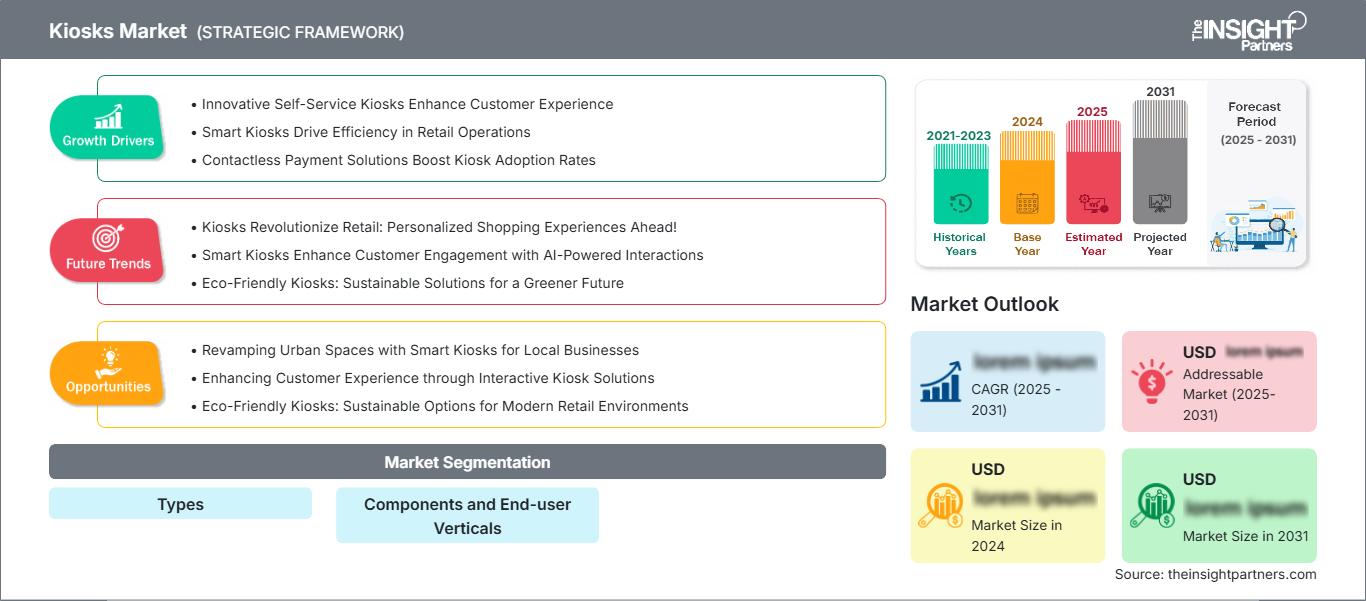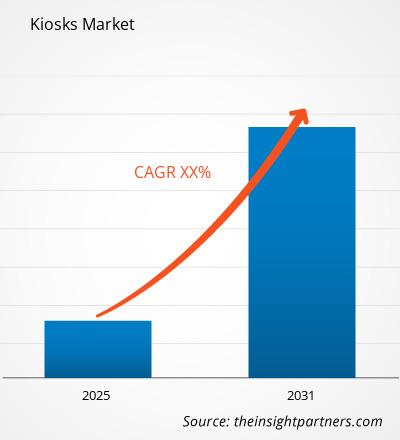Se prevé que el mercado de quioscos registre una tasa de crecimiento anual compuesta (CAGR) del XX% entre 2025 y 2031, con un tamaño de mercado que se expandirá de US$ XX millones en 2024 a US$ XX millones en 2031.
El informe se clasifica por tipos y analiza el mercado en función de los componentes y los sectores verticales de usuarios finales. Se ofrece un desglose completo a nivel global, regional y nacional para cada uno de estos segmentos clave.
El informe incluye el tamaño del mercado y las previsiones para todos los segmentos, con valores expresados en USD. Asimismo, proporciona estadísticas clave sobre la situación actual del mercado de los principales actores, junto con información sobre las tendencias de mercado predominantes y las oportunidades emergentes.
Finalidad del informe
El informe sobre el mercado de quioscos, elaborado por The Insight Partners, tiene como objetivo describir el panorama actual y el crecimiento futuro, los principales factores impulsores, los desafíos y las oportunidades. Esto proporcionará información valiosa a diversos actores del sector empresarial, tales como:
- Proveedores/fabricantes de tecnología: Para comprender la evolución de la dinámica del mercado y conocer las posibles oportunidades de crecimiento, lo que les permitirá tomar decisiones estratégicas informadas.
- Inversores: Realizar un análisis exhaustivo de las tendencias relativas a la tasa de crecimiento del mercado, las proyecciones financieras del mercado y las oportunidades que existen a lo largo de la cadena de valor.
- Organismos reguladores: Regular las políticas y controlar las actividades en el mercado con el objetivo de minimizar los abusos, preservar la confianza de los inversores y mantener la integridad y la estabilidad del mercado.
Segmentación del mercado de quioscos
Tipos
Componentes y sectores verticales de usuarios finales
Obtendrá personalización gratuita de cualquier informe, incluyendo partes de este informe, análisis a nivel de país y paquetes de datos de Excel. Además, podrá aprovechar excelentes ofertas y descuentos para empresas emergentes y universidades.
Mercado de quioscos: Perspectivas estratégicas

-
Obtenga las principales tendencias clave del mercado que se describen en este informe.Esta muestra GRATUITA incluirá análisis de datos, que abarcarán desde tendencias de mercado hasta estimaciones y pronósticos.
Factores que impulsan el crecimiento del mercado de quioscos
- Los innovadores quioscos de autoservicio mejoran la experiencia del cliente.
- Los quioscos inteligentes impulsan la eficiencia en las operaciones minoristas
- Las soluciones de pago sin contacto impulsan las tasas de adopción de quioscos
Tendencias futuras del mercado de quioscos
- Los quioscos revolucionan el comercio minorista: Experiencias de compra personalizadas en el futuro
- Los quioscos inteligentes mejoran la interacción con el cliente mediante interacciones impulsadas por IA.
- Quioscos ecológicos: Soluciones sostenibles para un futuro más verde
Oportunidades de mercado para quioscos
- Renovación de espacios urbanos con quioscos inteligentes para negocios locales
- Mejora de la experiencia del cliente mediante soluciones de quioscos interactivos
- Quioscos ecológicos: opciones sostenibles para entornos comerciales modernos
Perspectivas regionales del mercado de quioscos
Los analistas de The Insight Partners han explicado en detalle las tendencias y los factores regionales que influyen en el mercado de quioscos durante el período de previsión. Esta sección también analiza los segmentos del mercado de quioscos y su distribución geográfica en Norteamérica, Europa, Asia Pacífico, Oriente Medio y África, y Sudamérica y Centroamérica.
Alcance del informe de mercado de quioscos
| Atributo del informe | Detalles |
|---|---|
| Tamaño del mercado en 2024 | XX millones de dólares estadounidenses |
| Tamaño del mercado para 2031 | XX millones de dólares estadounidenses |
| Tasa de crecimiento anual compuesto global (2025 - 2031) | XX% |
| Datos históricos | 2021-2023 |
| período de previsión | 2025-2031 |
| Segmentos cubiertos | Por tipos, componentes y verticales de usuario final |
| Regiones y países cubiertos |
América del norte
|
| Líderes del mercado y perfiles de empresas clave |
|
Densidad de los actores del mercado de quioscos: comprensión de su impacto en la dinámica empresarial
El mercado de quioscos está creciendo rápidamente, impulsado por la creciente demanda de los usuarios finales debido a factores como la evolución de las preferencias de los consumidores, los avances tecnológicos y una mayor conciencia de las ventajas del producto. A medida que aumenta la demanda, las empresas amplían su oferta, innovan para satisfacer las necesidades de los consumidores y aprovechan las nuevas tendencias, lo que impulsa aún más el crecimiento del mercado.

- Obtenga una visión general de los principales actores del mercado de quioscos.
Puntos clave de venta
- Cobertura integral: El informe abarca de forma exhaustiva el análisis de productos, servicios, tipos y usuarios finales del mercado de quioscos, proporcionando una visión holística.
- Análisis de expertos: El informe se elabora a partir del profundo conocimiento de expertos y analistas del sector.
- Información actualizada: El informe garantiza su relevancia para el negocio gracias a su cobertura de información reciente y tendencias de datos.
- Opciones de personalización: Este informe se puede personalizar para satisfacer las necesidades específicas del cliente y adaptarse adecuadamente a las estrategias comerciales.
Por lo tanto, el informe de investigación sobre el mercado de quioscos puede ayudar a liderar el proceso de análisis y comprensión del panorama de la industria y sus perspectivas de crecimiento. Si bien existen algunas preocupaciones válidas, los beneficios generales de este informe tienden a superar las desventajas.
- Análisis histórico (2 años), año base, pronóstico (7 años) con CAGR
- Análisis PEST y FODA
- Tamaño del mercado, valor/volumen: global, regional y nacional
- Industria y panorama competitivo
- Conjunto de datos de Excel
Informes recientes
Testimonios
Razón para comprar
- Toma de decisiones informada
- Comprensión de la dinámica del mercado
- Análisis competitivo
- Información sobre clientes
- Pronósticos del mercado
- Mitigación de riesgos
- Planificación estratégica
- Justificación de la inversión
- Identificación de mercados emergentes
- Mejora de las estrategias de marketing
- Impulso de la eficiencia operativa
- Alineación con las tendencias regulatorias






















 Obtenga una muestra gratuita para - Mercado de quioscos
Obtenga una muestra gratuita para - Mercado de quioscos